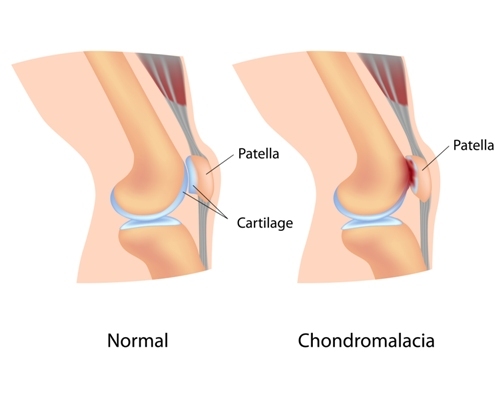Chondromalacia Patellae

Chondromalacia patella (knee pain) is the softening and breakdown of the tissue (cartilage) on the underside of the kneecap (patella). Pain results when the knee and the thigh bone (femur) rub together. Dull, aching pain and/or a feeling of grinding when the knee is flexed may occur. The most common way to treat symptoms of chondromalacia patella is to rest the knee.
What is chondromalacia patella?
Chondromalacia patella (knee pain) is the softening and breakdown of the tissue (cartilage) on the underside of the kneecap (patella). Pain results when the knee and the thigh bone (femur) rub together.
Who is at risk for chondromalacia patella?
People who are at risk for developing chondromalacia patella include:
- Those who are overweight
- People who have had an injury, fracture, or dislocation related to the kneecap
- Runners, soccer players, bicyclists, and other people who exercise often
- Teenagers and healthy young adults, more often females
What causes chondromalacia patella?
Chondromalacia patella often occurs when the undersurface of the kneecap comes in contact with the thigh bone causing swelling and pain. Abnormal knee cap positioning, tightness or weakness of the muscles associated with the knee, too much activity involving the knee, and flat feet may increase the likelihood of chondromalacia patella.
What are the symptoms of chondromalacia patella?
Dull, aching pain that is felt:
- Behind the kneecap
- Below the kneecap
- On the sides of the kneecap
A feeling of grinding when the knee is flexed may occur. This can happen:
- Doing knee bends
- Going down stairs
- Running down hill
- Standing up after sitting for awhile
How is chondromalacia patella diagnosed?
A doctor will perform a physical examination of the knee to determine the cause of pain. If the diagnosis is not clear or symptoms do not improve a doctor may order one of the following:
- Blood tests and/or a standard knee X-ray - This may help to rule out some types of arthritis or inflammation.
- MRI scan- A tests that shows details of the knee joint and can reveal many cases of chondromalacia patella.
- Arthroscopy - A tiny, flexible camera is inserted into the knee to see exactly what the cartilage looks like.

